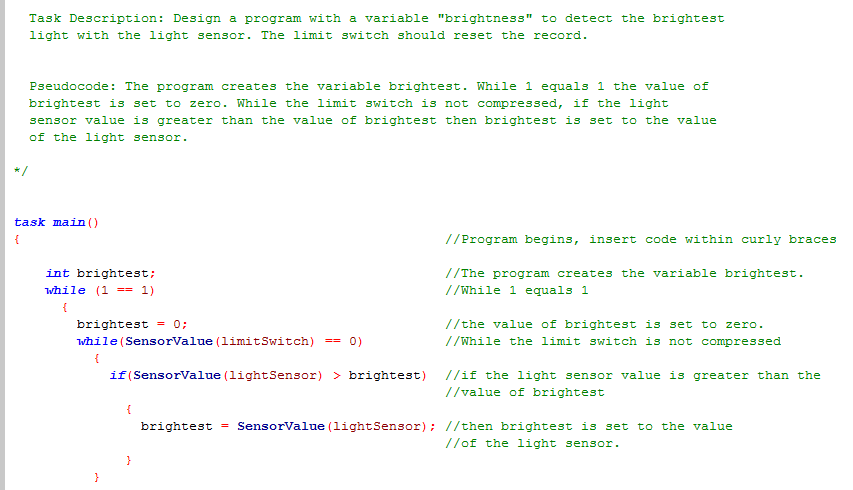
Open up your ROBOTC program so that you see this. However, such an output means, that you can adjust the thresholds you want to be recognized as blue very nicely in software: for example by saying if the blue value is the highest of those 3, you have a blue line and act accordingly. A cortex with at least 1 light sensor and 1 motor plugged into it.
ROBOTC LIGHT SENSOR CODE
This snippet of code will make the robot follow a dark line on a light surface for 5.0 seconds using a threshold of 505 and line tracking sensors in analog-ports in1, in2, and in3 (L, C, R) and then stop. The error I suspect is that SensorValue actually is a value from 0 to 255 and the chance that you get exactly the number sensorCOLORBLUE is very small. The robot will track a dark line on a light surface for a specified time in seconds. The larger the number, the brighter the incoming light. According to this page the sensor basically gives you three integers corresponding to the intensity of red/green/blue light.
ROBOTC LIGHT SENSOR SERIES
In this episode of the Basic NXT Programming series I will cover the sound sensor.
ROBOTC LIGHT SENSOR SOFTWARE
NxtDisplayTextLine(5, "Norm: %3d", normalisedValue) Configure VEX motors in RobotC programming software Icon marking that. The Light Sensor is an analog sensor, and it returns values in the range of 0 to 4095. Designing & Planning Reading Ambient Light.

Line -following (light) sensors analog (0 to 1024) Ultrasonic/sonar sensor. Unlike the Line Tracking Sensor, the Light Sensor does not generate any light, it only senses the amount of light already present in an area. Both NXT-G and RobotC allow you to set the sensor to generate light (or not). Sensors Motors ROBOTC programming examples Sample VEX robot projects. NxtDisplayTextLine(4, "Raw: %3d", rawValue) Light Sensor Overview Robotc The VEX light Sensor allows the robot to sense the ambient light in a room. NormalisedValue = normaliseReading(rawValue) This is an array of 8 sensors with controlled light source, returning you 8 discrete. Return ((long)(rawValue - blackValue) * 100) / (whiteValue - blackValue) Anything else should be calculated in a scale from 0-100% Anything less than the black value should return 0 Normalise a raw value, returns a value from 0 to 100 Calibration values, these may be different for you * Program to use the NXT 2.0 colour sensor as a standard Lego Light sensor *!!Code automatically generated by 'ROBOTC' configuration wizard !!*// #pragma config(Sensor, S1, COLOUR, sensorCOLORRED)

Tetrix12 V Motors 1 Tetrix Servo 1 Lego Motor 1 Lego Light Sensor 1 Lego NXT with batteries 1 Tetrix Battery. Find the SensorValue command on the left and drag and drop it into your code. Make sure you change the blackValue and whiteValue variables to match your own environment. RobotC Programming Making your robot move. Open up your ROBOTC program so that you see this. The only thing is you will need to do some work yourself to turn it into a normalised value (0-100).īelow is the code for a simple program that allows you to read both the raw value from the Colour Sensor and a normalised one. lightSensor, leftBump, rightBump, sonar, etc) to a sensor rather. Lego Mindstorms is a hardware and software structure which is produced by Lego for the development of programmable robots based on Lego building blocks.Each. The new colour sensor can be used in a very similar way. RobotC has a built-in wizard that can be used to configure the NXT sensors. The old Light Sensor uses a small red LED to illuminate the target and a small sensor to see how much was reflected. Using the NXT 2.0 Colour Sensor as an old fashioned NXT 1.0 Light Sensor as very simple in NXT-G but a little more involved in ROBOTC.


 0 kommentar(er)
0 kommentar(er)
